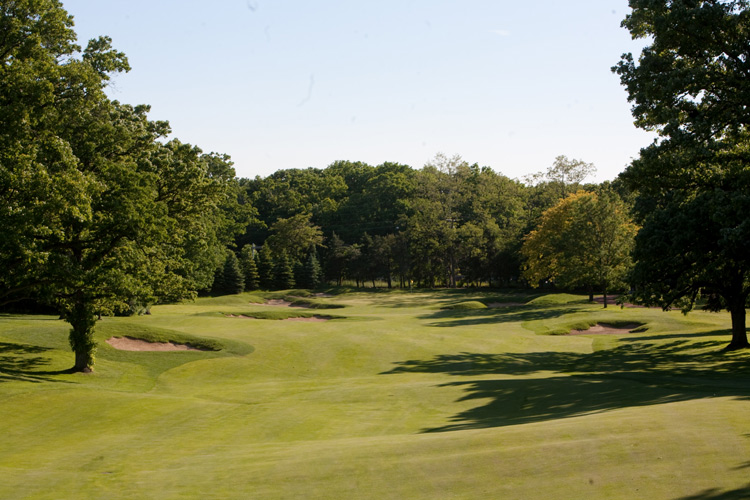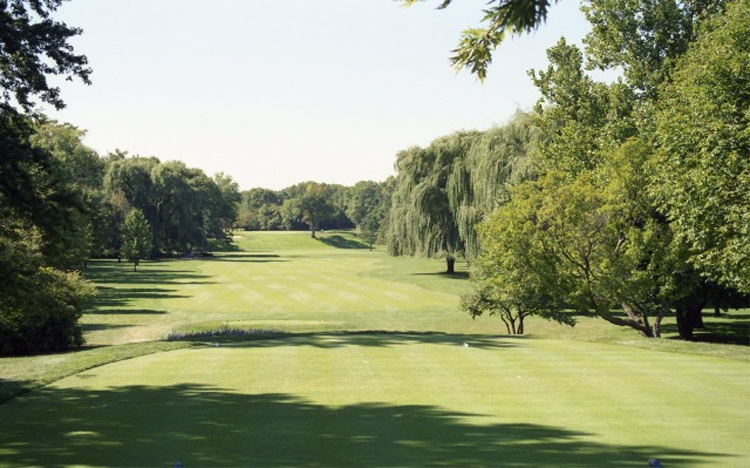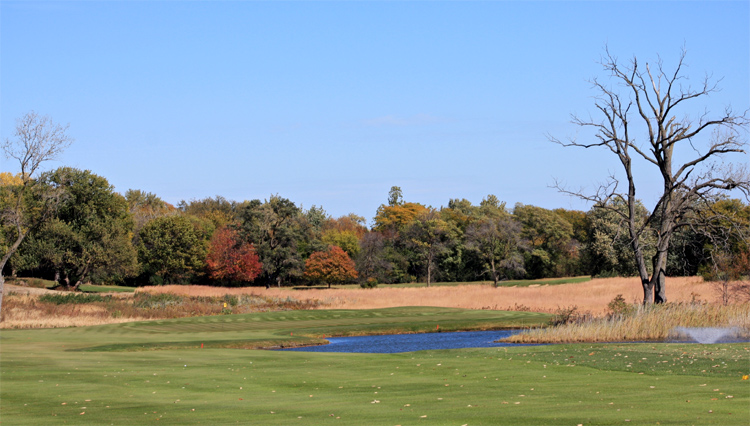Feature Interview with Ray Hearn and Bob Lively part 2
The following questions & answers are with Green Keeper Bob Lively:
10. Herbert Tweedie designed the course. Opened for play 1900, it was immediately highly regarded, hosting the western amateur in 1909. Yet, Tweedie died at the early age of 41 in 1906 and never capitalized on his growing reputation. Thus, he remains a ” no name” architect. What impresses you about Tweedie’s work at Flossmoor from an agronomic point of view?
What impresses me the most is how most of his original design and routing has stood the test of time for 112 years. WOW! So many great clubs have had their original designs changed so many times, that in my opinion, they can no longer be called an original. But they continue to because they were done by a big name in the past and their name stays with it to promote the club. Many of these clubs have also moved from their original locations, while Flossmoor still sits on the same site as it did in 1899. From an agronomic stand point, by not changing the original design or routing for the most part for 112 years, many of the maintenance practices have remained relatively the same, with the exception of the obvious turf grass advancements and the new equipment technologies that are available today. As a result, the course has been maintained the same way for many years, always standing the test of time.

Just look at the fairway contours of the fourteenth – all those ripples and small permutations are a clear sign that a bull dozer has never been over it.
11. How many willows were on the property when you became Green Keeper in 2002? How many willows are on the property now?
There were 55 mature willow trees on the property in 2002 and only two remain today. The two somewhat guard the 1st hole from the practice range. However, we have a plan from our architect, Ray Hearn, to renovate the existing driving range, and once that happens, those two willows will surely go as well. The dozen and a half willows that stood between the 17th and 18th fairways were actually the genesis of the entire restoration project as Hearn was first asked to just present a plan for the club to renovate the 18th hole, assuming the removal of those willows. I am personally thrilled to see almost all of them gone!

Taken in 2007, this view down the seventeenth shows a hole shrouded in willows.
12. Compare the quality of the turf pre and post tree removal. Where specifically have you seen the most improvement?
First of all there is NO comparison. The areas that were shaded and had restricted air movement performed poorly all season and especially in the summer. Once the trees were removed and the turf was opened to sunshine and open air movement, the turf responded immediately in a positive way. The par three 7th hole is probably the best example. It was surrounded by huge mature oak trees it didn’t see the summer’s sun for more than three hours a day on the green surface and probably less than one hour on the green surrounds. Therefore the green surface which is 90% poa-annua was very weak and shallow rooted. It was constantly wet and very thin in grass coverage at times. The green surrounds under these massive oaks had little to no turf and they were subject to even less sunlight and air movement. Since the tree removal, the 7th green and surrounds perform excellent just like any other hole on the course. Additionally, the tightly mown chipping area that was put in to replace the blue grass that surrounded the green has provided so many more interesting play options for players who miss this green off of the tee.
13. Tell us about your “ugly”, non-USGA spec greens. What’s their construction like? How do you keep them so firm? Why do other courses have so much difficulty with poa annua but you seem to make it thrive at Flossmoor? What do you do differently to control it?
Most superintendents would be offended if their greens were referred to as ugly, but there’s always an exception, and that would be me. We have so many different bio types of poa annua and bent grasses, for that matter, that the turf is naturally going to look funky. I use a lot of growth regulators which tends to discolor the turf, and I only use foliar fertilizers in season, at very low rates. I want to be in total control of the plant’s growth. You can always put more fertilizer on but you CAN’T take it off. By that I mean I spoon feed the greens in conjunction with the use of growth regulators, thus controlling their growth in the process. Our greens are not the vibrant green that you see every weekend on TV but most players really enjoy the golfing experience at Flossmoor, especially on the greens. Honestly, I like the off color yellowish-brown color you will see at Flossmoor because then I know that the greens will be firm and will putt true.
The construction of 14 of the 18 greens at Flossmoor, (the exceptions being #2 and #7 which are Collis greens and #8 and #13 which are Hearn greens), are original soil push-up greens. Only number 8 and 13 are designed to USGA specs. I deeptine aerate all my greens monthly to a 9 inch depth 7 times a year starting in April through October, using 3/8 inch solid needle tines. They are then rolled in two directions usually on Monday. By Tuesday, the ball roll is perfect and the members and guests don’t know I did anything. I try and lightly top dress the greens every two weeks in season and verticut them as weather allows. I am very stingy with water which helps them to remain firm. I can’t speak to what I do differently than any other superintendent, but I know that through years of experience (a lot of which has been trial and error ) I feel that I have got a solid program to maintain these particular greens the way the membership wants them to play. My philosophy has always been to maintain poa annua not eradicate it. A lot of people might not agree me, but so far I found success in my programs.
14. At a dinner in Chicago a few years ago, several non-members told me that the greens at Flossmoor are the most challenging in Illinois. I rolled my eyes in part because I had never been there and in part because Flossmoor doesn’t enjoy as high a profile as several of the other Golden Age courses around Chicago. To convey the difficulty of these greens, how would you describe them? Talk about the degree of pitch at such greens such as the 1st, 3rd, 4th, 10th, 11th, 12th, 14th, and 16th.
First of all, I cannot go on record saying my greens are the most challenging greens in Illinois as I personally don’t play enough golf outside of Flossmoor to justify such a statement. But I have heard many people that have played a lot golf all over Illinois as well as around the country, for that matter, that have said those exact words. Holes 3, 4, 10, 14, and 16 slope from back to front and holes 1, 11, and 12 slope from front to back. The slopes on these particular greens aren’t that obvious when players play them for the first time, which makes them very tricky. I have seen many befuddled players who make a one foot left to right read turn into a six foot miss as the green actually turn right to left – imagine their surprise and imagine what that does to them for the rest of the round!
The opening hole is a relatively short par five, but the fact that the green falls from the front left to the back right presents the player with a much more difficult approach than would be there if the green sloped from back to front like most greens built today. The player has the option to use a ground play as the green sits at the same grade as the fairway. This can be an effective way to execute this delicate shot.
The green at 11, our uphill par three, falls away from front left to back right, which presents a very challenging shot for the player from the tee. If one misses the green in one of the surrounding bunkers, this fall-off continues to cause shot difficulties, which makes it one of the more interesting par threes I have seen.
The green at twelve is again an extension of the fairway as the grade of the fairway, and ultimately the green, starts at around 125 yards out and falls away all through the green. You just don’t see this very often in North America (the first at Oakmont is a noted exception), but it makes for a very interesting hole.
These are just a couple of examples of the challenges our green complexes give the player around Flossmoor. I give tremendous credit to Herbert Tweedie for his great design work. His subtle internal contours are truly genius as players are often fooled by these breaks if they don’t pay enough attention to the real slopes that are presented.
15. At what green speed do you start losing the ability to use the best hole locations?
When green speeds exceed 12.5 on the stimpmeter, I do start losing some hole locations, but there are still plenty of excellent hole locations for me to use even at speeds above 12.5.
16. The last three holes play up, back and up to the clubhouse. Short grass stretches beyond all three hoes and up to the clubhouse. In addition, there is a continuous swath of fairway between the three hoes that measures close to 180 yards in width, making it one of the two or three widest fairway or lawn of any course in the United States. How much more time does it take to present all that short grass? Is it worth the effort?
Believe it or not it really doesn’t take me much more time to present all this bent grass because the additional short grass that connects these three fairways is really only what would be the rough area between the holes. Architect Ray Hearn wanted to create this “great lawn” effect by joining these three holes to mimic the large area of closely mown grass that exists right behind the clubhouse. In my opinion, he created quite a masterpiece everyone that plays here talks about. The last three holes at Flossmoor are three of the most challenging as well as beautiful finishing holes in the area.
17. Tell us about the native prairie grass areas being cultivated around the course. What drove the club to introduce these areas?
The property the club sits on was originally prairie, with several wooded areas. After the significant tree removal was completed, we felt like we should introduce some of the native Illinois prairie back to the property, That started on the front nine between holes two and three, holes three, four and five, and most recently behind the new eighth green. The additional of these prairie areas have opened up a number of great long views on the course which used to be completed obstructed by trees. We now want to introduce more native areas on the back nine to blend in with native areas we have on the front nine. At Flossmoor, we have the luxury of having 182 acres, which is a lot more room than most 18 hole clubs. The introduction of these native grasses also helps to reduce maintenance our costs by turning these areas into no mow areas.

The new prairie grassing schemes are true to the roots of this Midwest course and add great texture to the course.
18. If you were czar at Flossmoor, what work would you carry out in 2013?
I would go ahead with Ray Hearn’s original plan and change the 6th hole by moving the fairway away from the houses that the border the left side of the hole. This would be possible by removing some trees on the right side of the fairway and was the only part of Ray’s original master plan that didn’t get implemented.
Before signing off, I would like to recognize one person. My green’s chairman throughout this entire process, who shared my love and dedication for Flossmoor Country Club, was Mr. Mark Egge. Mark was there every day with me making sure that the best interests of the membership of Flossmoor Country Club were always met and he deserves credit for how well everything turned out.
THE END








